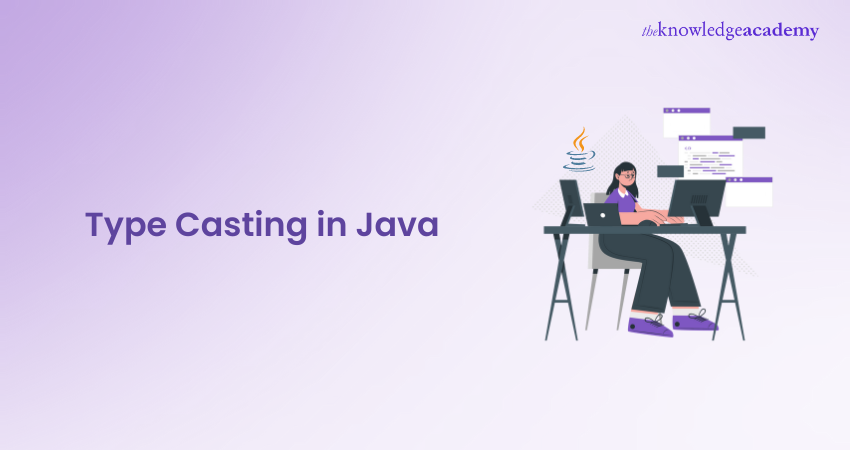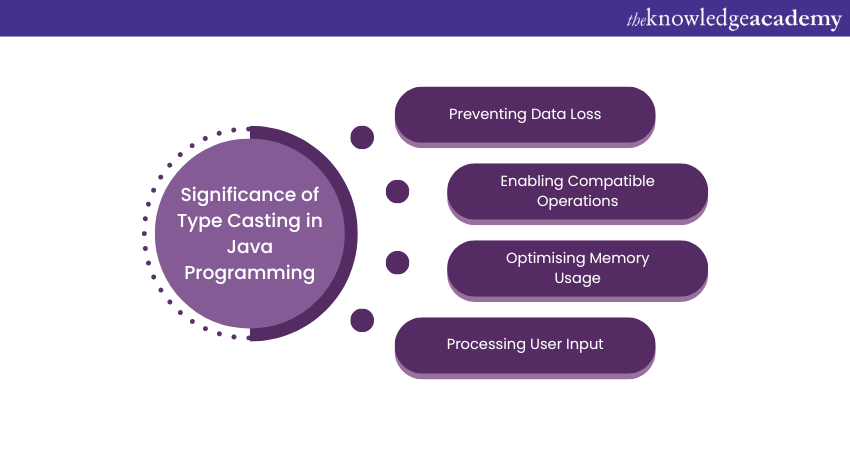We may not have the course you’re looking for. If you enquire or give us a call on + 1-866 272 8822 and speak to our training experts, we may still be able to help with your training requirements.
Training Outcomes Within Your Budget!
We ensure quality, budget-alignment, and timely delivery by our expert instructors.

The Type Casting in Java is a fundamental concept that stands at the heart of Java Programming. It helps Java smoothly convert one Data Types into another, preventing data loss and ensuring your program runs like a well-oiled machine.
Wondering, why Type Casting in Java is essential for preventing data loss and ensuring program efficiency? With this blog, we’ll unravel the secrets of Type Casting. We’ll explore how it works, why it matters, and how it keeps your Java applications efficient and error-free.
Table of Contents
1) What is Type Casting?
2) Importance of Type Casting in Java Programming
3) Categories of Type Casting
4) Examples of Type Casting in Java
5) Conclusion
What is Type Casting?
In Java, type casting (also known as type conversion) refers to the process of converting one Data Type into another. Java Type Casting is the process in which a specific kind of variable or object is converted to another variable or object. The following is an example of Type Casting:
|
double num1 = 10.5; int num2 = (int) num1; System.out.println(num2); |
In this example, we have a double variable, 'num1', with a value of 10.5. We then cast 'num1' to an integer kind of data using (int) before the variable name and store the result in an integer variable 'num2'.
Output:
10
This is because when we cast a double value to an integer, Java truncates the decimal part of the number and only retains the integer part. In this case, the decimal part of 10.5 is truncated, and we are left with the integer value 10.

Importance of Type Casting in Java Programming
Type Conversion and Casting are crucial in Java for several key reasons. Let’s talk about them in detail:

a) Preventing Data Loss: Type Casting ensures that when we change data from one type to another, we do not lose valuable information. It allows safe conversion while maintaining data integrity.
b) Making Operations Work: Different Data Types can’t always be mixed directly. Type casting makes operations possible by ensuring compatibility between data types.
c) Efficient Memory Use: Type Casting helps manage memory effectively. Using the right data type size prevents memory wastage.
d) Handling User Input: When dealing with user input (usually in text form), Type Casting converts it into numbers for proper processing.
e) Better Programming Control: Java’s strong typing benefits from type casting, allowing programmers to enforce correct data types.
Categories of Type Casting
As mentioned above, Type Casting converts a Data Type into another one. It would be beneficial to learn about its different categories with examples to further your understanding. The two major categories are:
Widening Type Casting
Widening Type Casting is the process or method where a lower kind of data is converted to a higher kind of data. This type of process is also known as Implicit/Automatic Type Casting, and this is because Java performs this without any explicit code writing automatically.
There are a few parameters that influence this. The first one is that there must be compatibility among both Data Types. The second is that the target type must be bigger than the source type. The following is an example:
int num = 10;
long longNum = num;
|
int num = 10; long longNum = num; |
In this example, there is an integer variable "num" with a value of 10, and the objective is to assign it to a variable of type long, which is a larger Data Type. The integer value 10 is automatically cast to a long value and then assigned to the variable "longNum".
Output:
|
longNum = 10; |
Widening type is always safe and can be done automatically by Java because there is no loss of precision or information when converting from a smaller Data Type to a larger Data Type.
Join our Java Engineer Training now and secure your spot in the tech industry's elite – register today!
Narrowing Type Casting
Narrowing Type Casting is the opposite of widening Type. The conversion of a higher type of data to a lower type of data is known as Narrowing Type Casting. It is also called an explicit conversion. This is because the process isn't automatic. Instead, it is done manually. This increases the chances of information or data loss. The following is an example:
|
double d = 1234.56; int i = (int) d; System.out.println(i); |
In this example, there is a 'double' variable 'd' with the value '1234.56'. The objective is to convert this to an 'int' variable 'i'. Since 'int' is a smaller Data Type than double, we need to use narrowing Type Casting to perform this conversion.
Output:
1234
Here, the decimal part of the original 'double' value is lost after the Type Casting. 'int' can represent a range of values smaller than that of a 'double', so the conversion may result in data loss or rounding errors in some cases.
Learn to build Web Applications with Java and more - sign up for our Web Development Using Java Training - Sign up now!
Examples of Type Casting in Java
Type Casting in Java refers to the process of converting a value from one Data Type to another. It's a crucial concept in programming, especially when you need to work with different Data Types or manipulate values to fit specific requirements. In this section, we'll explore four common examples of Type Casting in Java:
1) Converting int to Double
When you want to convert an integer (int) to a double (double), you can use explicit Type Casting. This conversion is also known as widening or upcasting because you're moving from a narrower data type (int) to a wider one (double). Here's an example:
|
public class Main { public static void main(String[] args) { // Create an int type variable int num = 50; System.out.println("The integer value: " + num); // Convert into double type double data = (double) num; System.out.println("The double value: " + data); } } |
In this example, we start with an integer variable num with the value 50. We explicitly cast it to a double using (double) and store the result in the data variable. When we print data, it will show the value as 50.0, demonstrating the conversion from int to double.
2) Converting Double Into an int
Converting a double to an int is a common operation when you want to discard the fractional part of a decimal number. It's essential to note that this conversion may result in data loss as you're narrowing the Data Type. Here's an example:
|
public class Main { public static void main(String[] args) { // Create a double type variable double doubleValue = 7.8; System.out.println("The double value: " + doubleValue); // Convert into int type int intValue = (int) doubleValue; System.out.println("The integer value: " + intValue); } } |
In this example, we start with a double variable doubleValue with the value 7.8. We explicitly cast it to an integer using (int) and store the result in the intValue variable. When we print intValue, it will display the value as 7, demonstrating the conversion from double to int.
3) Converting int to String
Converting an integer to a string is necessary when you want to represent numerical values as text. You can achieve this using the String.valueOf() method or by concatenating an empty string with the integer. Here's an example using the String.valueOf()
|
public class Main { public static void main(String[] args) { // Create an int type variable int intValue = 42; System.out.println("The integer value: " + intValue); // Convert into String type String stringValue = String.valueOf(intValue); System.out.println("The string value: " + stringValue); } } |
In this example, we start with an integer variable intValue with the value 42. We use String.valueOf() to convert it to a string and store the result in the stringValue variable. When we print stringValue, it will display "42", showing the conversion from int to string.
Master the fundamentals of JavaScript with our JavaScript for Beginners Course – Sign up now!
4) Converting String to int
Converting a string to an integer is common when you need to obtain numerical values from user input or external data sources. In Java, you can use the Integer.parseInt() method for this purpose. Let's take a look at an example here:
|
public class Main { public static void main(String[] args) { // Create a string containing a numeric value String stringValue = "123"; System.out.println("The string value: " + stringValue); // Convert into int type int intValue = Integer.parseInt(stringValue); System.out.println("The integer value: " + intValue); } } |
In this example, we start with a string variable stringValue containing the text "123". We use Integer.parseInt() to convert it to an integer and store the result in the intValue variable. When we print intValue, it will display the value as 123, demonstrating the conversion from string to int.
Conclusion
We hope this blog on Type Casting in Java has provided an in-depth explanation of the Programming intricacies. Being armed with examples and insights, you’re now ready to cast your way to coding excellence. Embrace the precision of Java and let type casting be your guide to crafting impeccable code.
Learn about the advanced concepts of Java with our Introduction to Java EE Training – sign up today!
Frequently Asked Questions

In Java, automatic Type Casting, also known as implicit Type Casting, is not supported between all Data Types. It occurs automatically when a value of a narrower Data Type is assigned to a variable of a wider Data Type without explicit casting. For instance, assigning an int to a double result in automatic Type Casting.

In Java, automatic type promotion typically happens when performing arithmetic operations involving mixed Data Types. For example, when you insert an int and a double, the int is automatically promoted to a double before the addition takes place.

The Knowledge Academy takes global learning to new heights, offering over 30,000 online courses across 490+ locations in 220 countries. This expansive reach ensures accessibility and convenience for learners worldwide.
Alongside our diverse Online Course Catalogue, encompassing 17 major categories, we go the extra mile by providing a plethora of free educational Online Resources like News updates, Blogs, videos, webinars, and interview questions. By tailoring learning experiences further, professionals can maximise value with customisable Course Bundles of TKA.

The Knowledge Academy’s Knowledge Pass, a prepaid voucher, adds another layer of flexibility, allowing course bookings over a 12-month period. Join us on a journey where education knows no bounds.

The Knowledge Academy offers various Java Courses, including Java Programming Course, JavaScript for Beginners and Java Engineer Training. These courses cater to different skill levels, providing comprehensive insights into Java Methodologies.
Our Programming & DevOps Blogs cover a range of topics related to Java, offering valuable resources, best practices, and industry insights. Whether you are a beginner or looking to advance your Java Programming skills, The Knowledge Academy's diverse courses and informative blogs have you covered.
Upcoming Programming & DevOps Resources Batches & Dates
Date
 Java Programming
Java Programming
Mon 18th Nov 2024
Mon 13th Jan 2025
Mon 10th Mar 2025
Mon 19th May 2025
Mon 21st Jul 2025
Mon 15th Sep 2025
Mon 17th Nov 2025
Mon 15th Dec 2025







 Top Rated Course
Top Rated Course


 If you wish to make any changes to your course, please
If you wish to make any changes to your course, please


